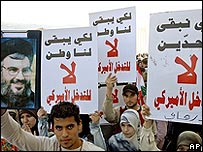 By Kim Ghattas, In the southern suburbs of Beirut, pictures of Ayatollah Ruhollah Khomeini, founder of Iran’s Islamic revolution, are not an uncommon sight.
By Kim Ghattas, In the southern suburbs of Beirut, pictures of Ayatollah Ruhollah Khomeini, founder of Iran’s Islamic revolution, are not an uncommon sight.
This is a stronghold of Hezbollah, the Iranian-backed Shia guerrilla movement and political party which looks to Iran and its supreme leader Ayatollah Ali Khamenei for spiritual guidance and more. In the aftermath of the summer 2006 war between Hezbollah and Israel, the group distributed around $300m dollars in aid, in crisp dollars bills. The money was thought to originate from Tehran.
In one apartment in the area, the television is playing a song in Farsi and in a corner there’s a big Iranian flag. These are the offices of Iranian engineer Hussam Khoshnevis, sent to Beirut by the Iranian President Mahmound Ahmadinejad, to help rebuild south Lebanon after the war. With his team, he is repairing some 50 bridges, 60 schools and 150 kilometres of highway and 30 places of worship, including churches – all destroyed by Israeli shelling.
Political stand-off
In total Mr Khoshnevis expects at least $250m to be spent on the reconstruction.
|
Juliette Wurr
US embassy in Beirut |
Many see this is as the Shia revolutionary state’s attempt to increase its hold over Lebanon and boost the power of the Shia guerrilla movement and political party Hezbollah in its stand-off against the government of Prime Minister Fouad Siniora.
The five-month long political crisis, in part over differing visions of Lebanon’s future, is one of the worst that the country has faced in decades. The engineer says Iran has no ulterior motives.
"We help all people in need, we don’t expect anything in return," he said.
"We helped Pakistan, Indonesia and our help fits in with the ideology of the Lebanese."

Israel did billions of dollars’ worth of damage to Lebanon last summer
|
But is help from other countries welcome, such as the US, which unequivocally backs Mr Siniora.
"We should respect all countries that offer help to Lebanon, it’s to the benefit of the people, except those countries that have a political agenda, and try to take away people’s dignity."
Mr Khoshnevis did not have to spell out what country he was referring to. It seemed obvious he meant the US.
Transparent intentions
"The United States has pledged one billion US dollars in aid," Juliette Wurr told me at the US embassy half an hour north of Beirut.
Around $30m dollars is going to rebuild a massive bridge in the eastern Bekaa valley, one of the tallest bridges in the Middle East.
|
Mohammed Shatah
Advisor to the PM |
Part of the aid has also been in the form of training and equipment, including Humvees, for the Lebanese army and the police force.
Critics say the US has an agenda when it gives aid and it is trying to influence the government and keep it firmly in the pro-Western camp.
"We’ve been very transparent with what we do, when we give money we talk about it, when we give military equipment we hold a ceremony, none of this is under-the-hand cash transfer," said Ms Wurr.
"Some other governments are not quite so transparent and some of them don’t even give their aid to legal entities but instead choose to use their assistance in ways to coerce or push people for political ends.
"Neither Syria nor Iran have played a very positive role recently in Lebanon."
Strategic battle
The US and Iran are both vying for influence here, trying to win the hearts and minds of the Lebanese and backing different parties – while the US supports the government, Iran and its ally Syria, support Hezbollah.

Divisions between Lebanese minorities are being reopened
|
"Iran is in a defensive state at the current time, it is positioned in a strategic axis, with Syria and Hamas, to confront US plans in the region," said Amal Saad Ghorayeb of the Carnegie Middle East think tank.
"I think it’s a battle between two strategic visions, and you have two domestic camps within Lebanon which adhere to one or the other and that’s the real problem."
In a country that often sums up all the complexities of the Middle East, it can get even more complicated.
Regional power-house Saudi Arabia has also been pumping aid and money into Lebanon.
The Sunni Muslim kingdom deposited $1bn in the central bank during the summer war to boost the Lebanese pound and paid fees for all pupils in state schools to a total of $30m, among other initiatives.
The Saudis are keen to keep Lebanon stable and prevent it from falling completely into the Syrian-Iranian orbit, at a time of Shia-Sunni tensions in the region.
No strings attached?
In a way, the Saudis are on the same side as the US in the stand off, but they also try to play a moderating role.
Many Lebanese are critical of the Saudi petro-dollars pouring into the country. But others, including the government say they welcome Saudi involvement and American aid because they believe it does not come with any strings attached.
"Iran has a certain affiliation with a community in Lebanon. We have a problem when that affinity between Iran and Hezbollah translates into a flow of weapons or an attempt to dictate a certain policy over Lebanon which is not agreed upon by other communities," said Mohammed Shatah, an advisor to the prime minister.
"We are concerned that Lebanon would become a theatre for the actual conflict between Iran and the US.
"In the past, Lebanon served as a theatre for other conflicts and this has cost the country dearly."
So once more, Lebanon finds itself at the centre of a regional power struggle and while the different outside players are helping to rebuild the small nation, their competing agendas may still bring it all down.



